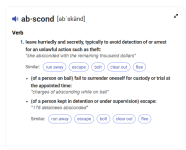- Joined
- Jul 10, 2015
- Messages
- 12,980
- Points
- 113
We will see about that.  A grand jury will see a lot of evidence.
A grand jury will see a lot of evidence.

Follow along with the video below to see how to install our site as a web app on your home screen.
Note: This feature may not be available in some browsers.



Texas Democrats have denied Texas Gov Greg Grabbitt a House quorum. Nothing illegal about that. In fact, I applaud them.
Democrats abandoned their seats and absconded from their duty, I expect they will face repercussions.Texas Democrats have denied Texas Gov Greg Grabbitt a House quorum. Nothing illegal about that. In fact, I applaud them.
That's funny. Authoritarians always accuse anyone in contention with doing exactly what they are doing. This is especially true about Trump. Abscond means to take or steal something. You can't abscond from your duty.Democrats abandoned their seats and absconded from their duty, I expect they will face repercussions.
Democrats are a lost party, underwater with their own base, powerless and without any message, democrats today are a party of grievances, cheaters and sore losers, many have past sins to be accounted for and I expect we will see them made to answer.
p.s. Ronald Regan was the Greatest President of our time.
I dysentery with this statement. I disaggregate with this remark.Democrats abandoned their seats and absconded from their duty, I expect they will face repercussions.
Yes, they stole them selves away from the people who elected then, from the duty they swore to do.That's funny. Authoritarians always accuse anyone in contention with doing exactly what they are doing. This is especially true about Trump. Abscond means to take or steal something. You can't abscond from your duty.

This was in response to your Democrats had absconded from their duty. Get it?
She absconded with the remaining thousand dollars does NOT mean run away. Neither do your other examples.

